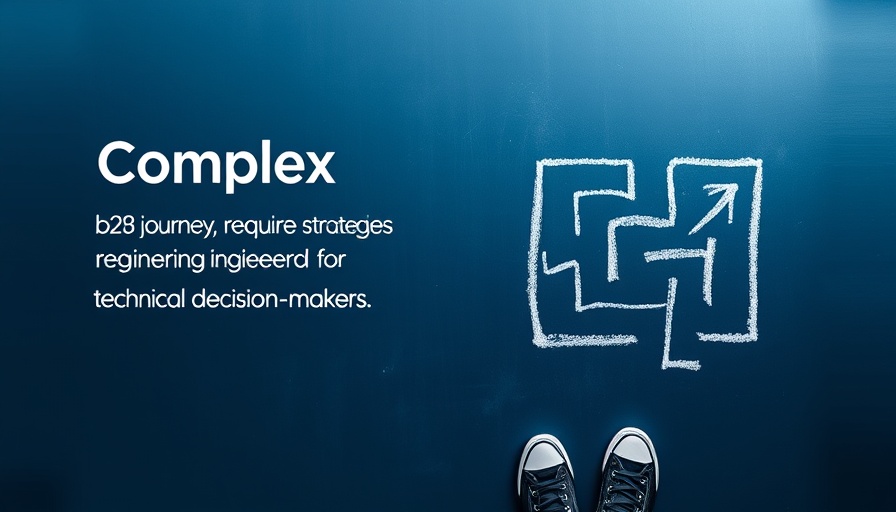
Understanding the Unique Landscape of B2B Paid Media
In the realm of digital advertising, B2B marketers encounter a distinct set of challenges that diverge significantly from the strategies effective in B2C marketing. While many agencies promote generic paid media solutions, the reality is that industrial B2B organizations require a tailored approach that aligns with their unique buying journeys and technical decision-making processes.
The Case for Specialized Approaches in Industries
As a marketing director at a B2B organization, you might have grappled with the frustration of agencies applying consumer-oriented tactics to your complex situations. It's an analogy akin to attempting to fit square pegs into round holes—while technically feasible with enough force, it rarely leads to optimal outcomes.
What Makes B2B Marketing Fundamentally Different?
B2B marketing is not necessarily more complex than its consumer counterpart; it is fundamentally distinct in structure and timeframes. Decision-making in B2B environments involves multiple stakeholders and typically encompasses longer timeframes and larger financial stakes. Most advertising platforms were initially designed with the quick, transactional nature of consumer purchases in mind, leading to inherent challenges for B2B marketers aiming to navigate these systems.
Failures of Consumer-Focused Strategies in B2B
The frameworks provided by popular advertising platforms often neglect the intricacies and nuances of industrial B2B sales processes. Understanding these limitations can illuminate why standard strategies frequently fall short:
- Misaligned Attribution Models: Many platforms attribute conversion value solely to the last click or interaction, ignoring the lengthy and convoluted decision journeys typical in B2B scenarios that can involve several months and numerous touchpoints.
- Short-term Optimization Bias: Automated bidding systems primarily promote quick conversions, potentially undermining the essential nurturing and relationship-building required for complex sales.
- Audience Targeting Limitations: Certain platforms, such as Reddit and Pinterest, lack the sophisticated targeting capabilities necessary to reach specific roles within target organizations effectively.
- Metrics Misalignment: Standard engagement metrics often fail to accurately reflect genuine progress in these intricate B2B processes.
Strategic Insights for Effective B2B Paid Media
Adapting to these unique challenges demands a deeper understanding of the market and the implementation of targeted strategies. Here are some actionable insights for improving your B2B paid media campaigns:
- Utilize Advanced Attribution Models: Invest in measurement frameworks that better account for multi-touch attribution, ensuring that every engagement along the customer journey is valued.
- Focus on Relationship Building: Long-term value should take precedence over immediate conversions. Implement nurturing sequences that guide potential clients through the decision-making process.
- Enhance Targeting Techniques: Leverage professional networks like LinkedIn to precisely target decision-makers and tailor your messaging according to their specific needs.
- Redefine Success Metrics: Develop metrics that encapsulate the entirety of the buyer's journey, focusing on engagement, content consumption, and lead progression.
Future Trends in B2B Paid Media
The future of B2B paid media is poised for transformation as new technologies and methodologies emerge. Automation, artificial intelligence, and data analytics will play vital roles in enhancing targeting capabilities and optimizing campaigns. Additionally, as buyer behavior continues to shift, adapting to the evolving landscape and embracing innovative strategies will be crucial for staying ahead in the competitive arena.
Conclusion: Embrace a Specialized Approach for Success
In sum, recognizing the critical differences between B2B and consumer marketing is not just beneficial but essential for developing effective paid media strategies. By embracing a tailored approach that addresses the unique needs of your audience, you will not only enhance your marketing efficacy but also build lasting relationships within your industry.
As you leverage these insights into your B2B marketing efforts, remember that specialized approaches offer significant advantages in navigating the intricate landscape of industrial marketing. It’s time to innovate your strategies and align them with the realities of your audience’s buying processes.
 Add Row
Add Row  Add
Add 




Write A Comment